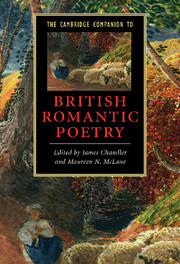Book contents
- Frontmatter
- Introduction: The companionable forms of Romantic poetry
- 1 The living pantheon of poets in 1820: pantheon or canon?
- 2 Romantic poetry and antiquity
- 3 Romantic meter and form
- 4 Romantic poetry and the standardization of English
- 5 Thinking in verse
- 6 Romantic poetry and the romantic novel
- 7 Wordsworth’s great Ode: Romanticism and the progress of poetry
- 8 Romantic poetry, sexuality, gender
- 9 Poetry, peripheries and empire
- 10 Romantic poetry and the science of nostalgia
- 11 Rethinking Romantic poetry and history: lyric resistance, lyric seduction
- 12 The medium of Romantic poetry
- 13 Romantic poets and contemporary poetry
- Index
- Series List
5 - Thinking in verse
Published online by Cambridge University Press: 28 November 2008
- Frontmatter
- Introduction: The companionable forms of Romantic poetry
- 1 The living pantheon of poets in 1820: pantheon or canon?
- 2 Romantic poetry and antiquity
- 3 Romantic meter and form
- 4 Romantic poetry and the standardization of English
- 5 Thinking in verse
- 6 Romantic poetry and the romantic novel
- 7 Wordsworth’s great Ode: Romanticism and the progress of poetry
- 8 Romantic poetry, sexuality, gender
- 9 Poetry, peripheries and empire
- 10 Romantic poetry and the science of nostalgia
- 11 Rethinking Romantic poetry and history: lyric resistance, lyric seduction
- 12 The medium of Romantic poetry
- 13 Romantic poets and contemporary poetry
- Index
- Series List
Summary
In his Biographia Literaria Coleridge took issue with the ideas about meter which Wordsworth had expressed in the “Preface” to the Lyrical Ballads. For Coleridge, Meter's chief function was a symbolic one. “I write in metre, because I am about to use a language different from that of prose.” Meter is a sign, which produces certain expectations about other linguistic features of the poem. If these expectations are disappointed, a kind of bathos will ensue. For Wordsworth, on the other hand, meter is not primarily a sign but, instead, is essentially connected to the fundamental organization of human knowing itself. We might characterize these accounts of meter, broadly speaking, as “symbolic” and “cognitive” respectively. For Coleridge's kind of account, the effects of meter are dependent upon recognition of a convention; for Wordsworth's kind of account, they depend upon the organization of consciousness itself.
What should be noted at once is that scholarship is still not in a position to settle this argument. For one kind of approach to meter, it is a meta-communicative feature of poetic discourse. In this approach it is imaginable that we can, for example, identify “iambic” pentameter as “a hegemonic form . . . a sign which excludes and includes, sanctions and denigrates, for it discriminates the 'properly' poetic from the 'improperly' poetic, Poetry from verse.” For other kinds of approach, meter is connected to the rhythmic organization of consciousness itself. The terrain remains disputed because, despite the startling developments of twentieth-century linguistics, there is still no science of verse.
- Type
- Chapter
- Information
- The Cambridge Companion to British Romantic Poetry , pp. 98 - 116Publisher: Cambridge University PressPrint publication year: 2008
- 5
- Cited by

